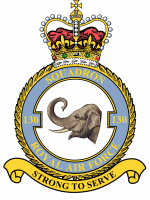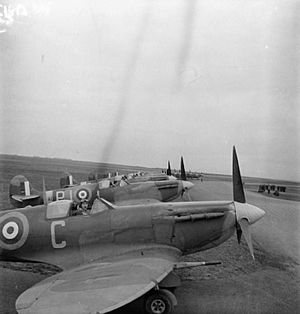No. 130 Squadron RAF facts for kids
Quick facts for kids No. 130 (Punjab) Squadron RAF |
|
|---|---|

Squadron badge
|
|
| Active | 1 Mar 1918 – 4 July 1918 16 June 1941 – 13 February 1944 5 April 1944 – 31 January 1947 1 August 1953 – 31 May 1957 1 December 1959 – 23 August 1963 |
| Country | |
| Branch | |
| Nickname(s) | Punjab |
| Motto(s) | Strong to serve |
| Insignia | |
| Squadron Badge heraldry | An elephant's head couped. Elephants are formidable opponents and are associated with the Punjab. |
| Identification symbol |
PJ 1941 - Feb 1944 AP Apr 1944 - 1947 |
No. 130 Squadron was a special group in the Royal Air Force (RAF). They flew fighter planes during the Second World War and the Cold war. Later, they even handled powerful missiles.
Contents
History of No. 130 Squadron
No. 130 Squadron was formed and disbanded several times. Each time, they played an important role in defending the UK or supporting its allies.
Early Days: World War I Training
The squadron first started on March 1, 1918. It was part of the Royal Flying Corps, which later became the RAF. They were based at RAF Wyton and then RAF Hucknall. Their job was to train pilots and observers. They learned to fly the Airco DH.9 plane. Once enough crews were ready for duty, the squadron was disbanded on July 4, 1918.
Reforming for World War II: The Punjab Squadron
The squadron was formed again on June 16, 1941. It was named No. 130 (Punjab) Squadron. This was because the state of Punjab donated money. This money helped buy a squadron of Supermarine Spitfire planes.
They were based at Portreath in Cornwall, England. Their first job was to patrol the seas. They looked for enemy ships in the waters near England. During summer, they flew fighter missions over northern France. They would fly to bases in southeast England for these missions. Then they returned to Cornwall at night.
When winter came, they went back to coastal patrols. In March 1943, they moved north to Scotland. After a break, they moved back to RAF West Malling in Kent. They continued missions over France. This only lasted a month, and they moved north again. This was because they needed more experienced pilots. The squadron was disbanded on February 13, 1944, at RAF Scorton.
Supporting the Normandy Invasion
To keep the "Punjab" tradition alive, 186 Squadron was renamed. It became No. 130 (Punjab) on April 5, 1944. They were based at RAF Lympne and still flew Spitfires. They flew daily missions to protect bomber planes. They also helped with air-sea rescue. They searched for survivors and protected rescue aircraft.
For Operation Overlord, the D-Day invasion in June 1944, the squadron was very busy. They flew the Spitfire V LF. They operated from a temporary airfield at Horne, Surrey. Their job was to protect the beaches of Normandy. They also guarded the ships using the special Mulberry harbours.
Fighting V-1 Flying Bombs
In August 1944, the squadron moved to RAF Tangmere. They got new, more powerful Spitfire XIV planes. These planes had a special Griffon engine. The new Spitfires were used for "Diver" missions. This meant they intercepted and shot down V-1 flying bombs. These were unmanned bombs sent by the enemy.
As the war continued in Europe, the squadron started ground-attack missions. They attacked enemy targets on the ground in France. In October, they moved to Belgium to continue these missions. They returned to England in May 1945.
The Jet Age and Cold War Missions
After moving to RAF Odiham in 1946, the squadron changed. They became one of the first groups to fly jet fighters. They flew the de Havilland Vampire jet. On January 31, 1947, the squadron was disbanded again. It was re-numbered as 72 Squadron.
In 1953, the squadron was formed once more. They flew Vampires as part of British forces in Germany. Their job was to defend the British sector. They later got North American Sabre jets. These were temporary until they received the new Hawker Hunter fighter in 1956. The squadron was disbanded at RAF Bruggen on April 30, 1957.
Strategic Missiles: The Thor Program
The squadron reformed for the last time on December 1, 1959. They were based at RAF Polebrook. This time, they were a Strategic Missile (SM) squadron. They were part of Project Emily. The squadron was equipped with three powerful Thor missiles.
In October 1962, the world faced the Cuban Missile Crisis. During this time, the squadron was on high alert. Their missiles were aimed at important targets in the USSR. The squadron was disbanded for good in August 1963. This happened when the Thor Program ended in the United Kingdom.
Aircraft and Missiles Used
No. 130 Squadron used many different aircraft and even missiles during its history. Here's a list of what they operated:
| From | To | Aircraft / Missile | Type |
|---|---|---|---|
| 1918 | 1918 | Airco DH.9 | Biplane bomber |
| 1941 | 1941 | Supermarine Spitfire | Mark IIA |
| 1941 | 1944 | Supermarine Spitfire | Mark VA and VB |
| 1944 | 1945 | Supermarine Spitfire | Mark XIV |
| 1945 | 1946 | Supermarine Spitfire | Mark IX |
| 1946 | 1947 | de Havilland Vampire | F1 Jet Fighter |
| 1953 | 1956 | North American Sabre | F4 Jet Fighter |
| 1956 | 1957 | Hawker Hunter | F4 Jet Fighter |
| 1959 | 1963 | Thor IRBM | Ballistic Missile |


